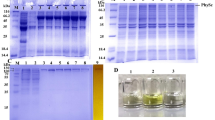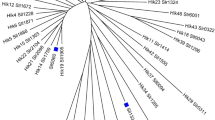Abstract
Three upstream kinases, Pak1, Tos3 and Elm1, are able to activate the Snf1 kinase. Since the Snf1 kinase itself assembles into three complexes that differ in their beta subunit identity, the possibility exists that each upstream kinase might be dedicated to a single isoform of the Snf1 kinase. To test this dedicated activator hypothesis, we generated a series of yeast strains that lacked different combinations of upstream kinases and beta subunits. Cells expressing only one of the three upstream kinases exhibited distinct abilities to activate Snf1, depending on the beta subunit present in the Snf1 kinase complex and the stress imposed on the cells. Pak1 and Gal83 were the most promiscuous. Pak1 was able to activate all three isoforms of the Snf1 kinase under all stress conditions tested. The Gal83 isoform of Snf1 was able to be activated by any of the three upstream kinases under aerobic growth conditions but showed a preference for Pak1 during growth on raffinose. Our results indicate that the three Snf1-activating kinases are not dedicated to specific isoforms of the Snf1 kinase. Instead, the different isoforms of the Snf1 kinase display stress-dependent preferences for the Pak1, Tos3 and Elm1 kinases.









Similar content being viewed by others
References
Bouquin N, Barral Y, Courbeyrette R, Blondel M, Snyder M, Mann C (2000) Regulation of cytokinesis by the Elm1 protein kinase in Saccharomyces cerevisiae. J Cell Sci 113:1435–1445
Carlson M (1999) Glucose repression in yeast. Curr Opin Microbiol 2:202–207
Celenza JL, Carlson M (1986) A yeast gene that is essential for release from glucose repression encodes a protein kinase. Science 233:1175–1180
Celenza JL, Eng FJ, Carlson M (1989) Molecular analysis of the SNF4 gene of Saccharomyces cerevisiae: evidence for physical association of the Snf4 protein with the Snf1 protein kinase. Mol Cell Biol 9:5045–5054
Cho RJ, et al (1998) A genome-wide transcriptional analysis of the mitotic cell cycle. Mol Cell 2:65–73
Cullen PJ, Sprague GF (2000) Glucose depletion causes haploid invasive growth in yeast. Proc Natl Acad Sci USA 97:13619–13624
Elbing K, Stahlberg A, Hohmann S, Gustafsson L (2004) Transcriptional responses to glucose at different glycolytic rates in Saccharomyces cerevisiae. Eur J Biochem 271:4855–4864
Ganster RW, McCartney RR, Schmidt MC (1998) Identification of a calcineurin-independent pathway required for sodium ion stress response in Saccharomyces cerevisiae. Genetics 150:31–42
Garrett JM (1997) The control of morphogenesis in Saccharomyces cerevisiae by Elm1 kinase is responsive to RAS/cAMP pathway activity and tryptophan availability. Mol Microbiol 26:809–820
Gasch AP, et al (2000) Genomic expression programs in the response of yeast cells to environmental changes. Mol Biol Cell 11:4241–4257
Gavin AC, et al (2002) Functional organization of the yeast proteome by systematic analysis of protein complexes. Nature 415:141–147
Ghaemmaghami S, et al (2003) Global analysis of protein expression in yeast. Nature 425:737–741
Hardie DG, Carling D, Carlson M (1998) The AMP-activated/SNF1 protein kinase subfamily: metabolic sensors of the eukaryotic cell?. Annu Rev Biochem 67:821–855
Hedbacker K, Hong SP, Carlson M (2004a) Pak1 protein kinase regulates activation and nuclear localization of Snf1-Gal83 protein kinase. Mol Cell Biol 24:8255–8263
Hedbacker K, Townley R, Carlson M (2004b) Cyclic AMP-dependent protein kinase regulates the subcellular localization of Snf1-Sip1 protein kinase. Mol Cell Biol 24:1836–1843
Ho Y, et al (2002) Systematic identification of protein complexes in Saccharomyces cerevisiae by mass spectrometry. Nature 415:180–183
Hohmann S, et al (1999) Novel alleles of yeast hexokinase PII with distinct effects on catalytic activity and catabolite repression of SUC2. Microbiology 145:703–714
Hong SP, Leiper FC, Woods A, Carling D, Carlson M (2003) Activation of yeast Snf1 and mammalian AMP-activated protein kinase by upstream kinases. Proc Natl Acad Sci USA 100:8839–8843
Hovland PG, Tecklenberg M, Sclafani RA (1997) Overexpression of the protein kinase Pak1 suppresses yeast DNA polymerase mutations. Mol Gen Genet 256:45–53
Huh WK, et al (2003) Global analysis of protein localization in budding yeast. Nature 425:686–691
Iyer VR, Horak CE, Scafe CS, Botstein D, Snyder M, Brown PO (2001) Genomic binding sites of the yeast cell-cycle transcription factors SBF and MBF. Nature 409:533–538
Jiang R, Carlson M (1996) Glucose regulates protein interactions within the yeast SNF1 protein kinase complex. Genes Dev 10:3105–3115
Jiang R, Carlson M (1997) The Snf1 protein kinase and its activating subunit, Snf4, interact with distinct domains of the Sip1/Sip2/Gal83 component in the kinase complex. Mol Cell Biol 17:2099–2106
Koehler CM, Myers AM (1997) Serine-threonine protein kinase activity of Elm1p, a regulator of morphologic differentiation in Saccharomyces cerevisiae. FEBS Lett 408:109–114
McCartney RR, Schmidt MC (2001) Regulation of Snf1 kinase. Activation requires phosphorylation of threonine 210 by an upstream kinase as well as a distinct step mediated by the Snf4 subunit. J Biol Chem 276:36460–36466
Moriya H, Isono K (1999) Analysis of genetic interactions between DHH1, SSD1 and ELM1 indicates their involvement in cellular morphology determination in Saccharomyces cerevisiae. Yeast 15:481–496
Mortensen EM, McDonald H, Yates J III, Kellogg DR (2002) Cell cycle-dependent assembly of a Gin4-septin complex. Mol Biol Cell 13:2091–2105
Nath N, McCartney RR, Schmidt MC (2002) Purification and characterization of snf1 kinase complexes containing a defined beta subunit composition. J Biol Chem 277:50403–50408
Nath N, McCartney RR, Schmidt MC (2003) Yeast pak1 kinase associates with and activates snf1. Mol Cell Biol 23:3909–3917
Rose MD, Winston F, Hieter P (1990) Methods in yeast genetics. Cold Spring Harbor Laboratory, Cold Spring Harbor, N.Y.
Schmidt MC, et al (1999) Std1 and Mth1 proteins interact with the glucose sensors to control glucose-regulated gene expression in Saccharomyces cerevisiae. Mol Cell Biol 19:4561–4571
Schmidt MC, McCartney RR (2000) Beta-subunits of Snf1 kinase are required for kinase function and substrate definition. EMBO J 19:4936–4943
Shirra MK, Arndt KM (1999) Evidence for the involvement of the Glc7-Reg1 phosphatase and the Snf1-Snf4 kinase in the regulation of INO1 transcription in Saccharomyces cerevisiae. Genetics 152:73–87
Sikorski RS, Hieter P (1989) A system of shuttle vectors and yeast host strains designed for efficient manipulation of DNA in Saccharomyces cerevisiae. Genetics 122:19–27
Smith FC, Davies SP, Wilson WA, Carling D, Hardie DG (1999) The SNF1 kinase complex from Saccharomyces cerevisiae phosphorylates the transcriptional repressor protein Mig1p in vitro at four sites within or near regulatory domain 1. FEBS Lett 453:219–223
Southern JA, Young DF, Heaney F, Baumgartner WK, Randall RE (1991) Identification of an epitope on the P and V proteins of simian virus 5 that distinguishes between two isolates with different biological characteristics. J Gen Virol 72:1551–1557
Spellman PT, et al (1998) Comprehensive identification of cell cycle-regulated genes of the yeast Saccharomyces cerevisiae by microarray hybridization. Mol Biol Cell 9:3273–3297
Sreenivasan A, Bishop AC, Shokat KM, Kellogg DR (2003) Specific inhibition of Elm1 kinase activity reveals functions required for early G1 events. Mol Cell Biol 23:6327–6337
Sutherland CM, et al (2003) Elm1p is one of three upstream kinases for the Saccharomyces cerevisiae Snf1 complex. Curr Biol 13:1299–1305
Thomas CL, Blacketer MJ, Edgington NP, Myers AM (2003) Assembly interdependence among the S. cerevisiae bud neck ring proteins Elm1p, Hsl1p and Cdc12p. Yeast 20:813–826
Treitel MA, Carlson M (1995) Repression by SSN6-TUP1 is directed by MIG1, a repressor/activator protein. Proc Natl Acad Sci USA 92:3132–3136
Treitel MA, Kuchin S, Carlson M (1998) Snf1 protein kinase regulates phosphorylation of the Mig1 repressor in Saccharomyces cerevisiae. Mol Cell Biol 18:6273–6280
Vincent O, Carlson M (1999) Gal83 mediates the interaction of the Snf1 kinase complex with the transcription activator Sip4. EMBO J 18:6672–6681
Vincent O, Townley R, Kuchin S, Carlson M (2001) Subcellular localization of the Snf1 kinase is regulated by specific beta subunits and a novel glucose signaling mechanism. Genes Dev 15:1104–1114
Young ET, Dombek KM, Tachibana C, Ideker T (2003) Multiple pathways are co-regulated by the protein kinase Snf1 and the transcription factors Adr1 and Cat8. J Biol Chem 278:26146–26158
Acknowledgements
This work was supported by grant GM46443 from the National Institutes of Health. We thank Anna Leech for countless PCR reactions to confirm genotypes and thank Karen Arndt for critical reading of this manuscript.
Author information
Authors and Affiliations
Corresponding author
Additional information
Communicated by S. Hohmann
Rights and permissions
About this article
Cite this article
McCartney, R.R., Rubenstein, E.M. & Schmidt, M.C. Snf1 kinase complexes with different beta subunits display stress-dependent preferences for the three Snf1-activating kinases. Curr Genet 47, 335–344 (2005). https://doi.org/10.1007/s00294-005-0576-2
Received:
Revised:
Accepted:
Published:
Issue Date:
DOI: https://doi.org/10.1007/s00294-005-0576-2




